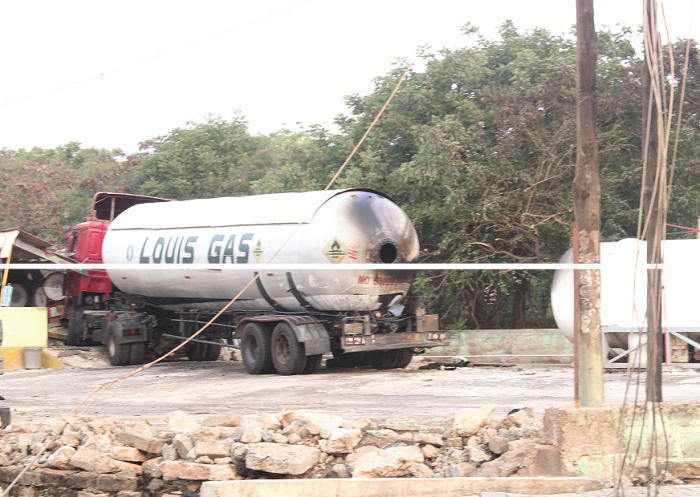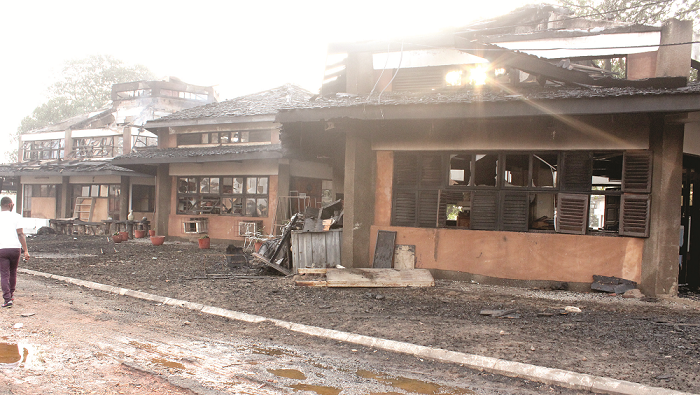EPA closes down LPG station at La (Dec 24, 2016)

The Environmental Protection Agency (EPA) has shut down the liquefied petroleum gas (LPG) station that exploded last Thursday and left nine dead and more than 12 injured. Other reports put the death toll at six.
The decision to close down the station and an adjoining one is to make way for the evacuation of gas to prevent what the head of the agency’s Built Environment said was to prevent “any further danger to public health and safety.”
“We are still investigating the cause of the fire, so it is very important that we evacuate the fuel to prevent any possible explosion," Ms Cindy Badoe told the Daily Graphic.
A day after the disaster, a combined team from the EPA, National Petroleum Authority (NPA), the Ghana National Fire Service (GNFS), Trinity Gas and the Ghana Police Service were busily fixing tubes to evacuate the gas.
A vessel belonging to Trinity Gas was on site to be connected to the tanks at the station to cart away the LPG.
Fire officers were still spraying water at the site where the evacuation exercise was ongoing.
Three buildings belonging to the Aid to Artisans, a non-governmental organisation (NGO), have been reduced to a pile of debris, while pick-up trucks and a Range Rover belonging to Mr Raymond Archer, the publisher of the Enquirer newspaper, were also affected. Additionally, the roof of the printing house where Mr Archer operated was also destroyed.
Not even the GNFS office in the area was spared.
The entire road, where the accident occurred, remained closed to the public as the authorities maintained a firm grip on the prevention of any disaster.
Last Thursday’s explosion is the second time in 19 months that a gas explosion has claimed lives—the last time being the bang at Dansoman which killed two in April last year.
A Chief Programme Officer of the EPA, Mr William Hayfron Acquah, who was part of the team in charge of the evacuation, described the incident as “unfortunate given the number of casualties.”
He said as a precaution, the road would remain closed even after the evacuation because the concentration of gas still remained very high in portions of drains in the area.
“If there is any source of heat, it could ignite fire and, therefore, it would be safe that even after we have carried the gas away, we will keep the road closed today, so that by tomorrow, it will be safe for vehicles to use. This will ensure that there will not be sparks to generate fire.”
On the cause of the fire, he said from preliminary investigations, it was an operational challenge.
“There was a pressure built up in a vessel as a result of which the neck of the vessel was out because of excessive pressure, it leaked and once there was a leakage of gas and there was any source of heat, it would trigger fire. That was what happened.
“Because of the wind direction from the station towards the downstream (Trade Fair), the fire spread to that end. The pressure pushed the fire beyond the wall and that was how come it travelled all the way inside the Trade Fair.”
With the public already pointing accusing fingers at regulatory institutions, including the EPA for the spate of gas explosions, Mr Hayfron refused to accept any blame for the incident.
He said the EPA had not failed the nation as it had constantly followed its regulatory procedures and consistently inspected sites before renewing permits.

One of the buildings at the Ghana International Trade Fair Centre was caught up in the fire.
Eyewitness accountAn eyewitness, Mr Acher, told the Daily Graphic that “about 5.30 p.m, we heard this massive explosion as if a plane had crashed. The Range Rover which was parked in front of the office was lifted and landed.
Then we heard a second explosion, my workers were trying to come out but I blocked the door. Just seconds later, we saw this fireball that zoomed pass. The fire was this big ball and it was just rolling,” he said pointing to a height that could be about 10 feet from the ground.
He said the good thing was that the night shift had not started.
“If this had happened five minutes later, all of them would have been outside and this would have been a catastrophe. I took some of the injured to hospital,” he said.
LPG station siting
Although the current incident is far from residential facilities, over the years, there has been growing public concern over the siting of LPG and fuel stations in residential areas in Accra.
Even though there is a guideline that regulates the siting of such services, violations of the regulations by fuel and LPG station owners and some recalcitrant people who build so close to the facilities are exposing the lives of the public to danger.
The practice is particularly widespread in Accra and other regional capitals where the stations are built very close to homes, shops, churches, offices and even refuse dumps.
Apart from explosions, other identified risks associated with the installation and operation of LPG refilling plants include air pollution, particularly during discharge, occupational and public health safety as well as the impact on land use.
Worrying statistics
Reports from Daily Graphic archives from 2007 to 2014 indicate that while 39 people died, 186 people sustained various degrees of injury in the 11 reported accidents involving LPG tankers and LPG filling stations as well as domestic calamities.
Out of the 11 accidents, five involved industrial settings — gas stations, fuel stations and a fuel dump — while three were gas tanker crashes, with the remaining three being domestic accidents.
By law, safety standards are a requirement for the granting of permits to site gas filling stations but the law has been flouted with impunity in many areas.
Approval for the building of fuel and LPG stations requires permits from the regulatory agencies, including the EPA, the Town and Country Planning Department (TCPD), the NPA and the district assemblies.

Comments
Post a Comment